 This is a Salyut (Салют), a medium format SLR produced at the Arsenal plant in Kyiv, Soviet Union between the years 1957 and 1972. The Salyut was the first Soviet made medium format SLR, and is very similar, but not an exact copy of the original Hasselblad 1000 F. It has a removable viewfinder, supports interchangeable film magazines, shoots twelve 6cm x 6cm images on 120 roll film, and has a focal plane shutter with speeds up to 1/1000. Earlier Salyuts went as high as 1/1500, but these speeds were not reliable. The Salyut was very expensive when it was built, roughly half a year’s salary of the average Soviet worker, so was sold and produced in very low numbers. Despite the low numbers, the camera remained in production for quite a while, launching several other variants.
This is a Salyut (Салют), a medium format SLR produced at the Arsenal plant in Kyiv, Soviet Union between the years 1957 and 1972. The Salyut was the first Soviet made medium format SLR, and is very similar, but not an exact copy of the original Hasselblad 1000 F. It has a removable viewfinder, supports interchangeable film magazines, shoots twelve 6cm x 6cm images on 120 roll film, and has a focal plane shutter with speeds up to 1/1000. Earlier Salyuts went as high as 1/1500, but these speeds were not reliable. The Salyut was very expensive when it was built, roughly half a year’s salary of the average Soviet worker, so was sold and produced in very low numbers. Despite the low numbers, the camera remained in production for quite a while, launching several other variants.
Film Type: 120 Roll Film (twelve 6cm x 6cm exposures per roll)
Lens: 80mm f/2.8 Industar-29 coated 4-elements in 3-groups
Lens Mount: Salyut/Hasselblad Bayonet
Focus: 0.9 meters to Infinity
Viewfinder: Interchangeable Waist Level Reflex Viewfinder
Shutter: Metal Foil Focal Plane
Speeds: B, 1/2 – 1/1000 seconds
Exposure Meter: None
Battery: None
Flash Mount: PC Socket M and X Flash Sync, 1/30 X-Sync
Weight: 1462 grams, 1130 grams (body, back, and hood), 692 grams (body and hood), 624 grams (body only)
Manual (in Russian): https://mikeeckman.com/media/SalyutManual.pdf
Manual (similar model): https://www.butkus.org/chinon/russian/zenith_80/zenit_80.pdf
Manual (similar model in Russian): http://www.rangefinder.ru/manual/instructions/cameras/salut_s.pdf
How these ratings work |
The Arsenal Salyut was built to compete as a lower cost alternative to Hasselblad medium format SLRs, a role that the cameras still serve today. On the used market a working Salyut can be had for 1/4th the price or lower than a working Hasselblad. Operation is similar enough to give a Hasselblad experience, and with the excellent results from the 80mm Industar-29, few people would ever know which camera shot the images the Salyut is capable of. Of course, like all half century plus old cameras, the key is to get one in good operating condition. The earlier Salyuts are said to be better built, but I think a lot of that has to do with sample selection and how the camera was cared for. Nevertheless, if you are fortunate enough to come across a nice working Salyut, it’s close enough to that of a real Hasselblad, and you’d likely not be able to justify the price difference. | ||||||
| Images | Handling | Features | Viewfinder | Feel & Beauty | History | Age | |
| 2 | 2 | 1 | 1 | 2 | 1 | 30% | |
| Bonus | none | ||||||
| Final Score | 11.7 | ||||||
History
 The Arsenal factory in Kiev, Ukraine has a long history dating back as far as 1764 as a repair and production facility for the Russian military. It would change locations a number of times and by the early 20th century would grow into one of the Soviet Union’s largest manufacturing facilities.
The Arsenal factory in Kiev, Ukraine has a long history dating back as far as 1764 as a repair and production facility for the Russian military. It would change locations a number of times and by the early 20th century would grow into one of the Soviet Union’s largest manufacturing facilities.
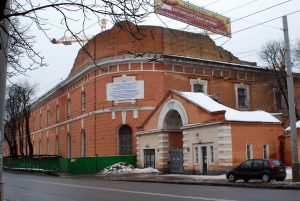
Prior to World War II, Arsenal produced a variety of military goods, but little to nothing for the civilian market, and certainly no cameras. After the war, when the Soviet Union took over what became East Germany, they seized much of the manufacturing equipment and spare parts from various Dresden area camera manufacturers like Zeiss-Ikon and transported it to Kiev.
The Soviet Union was no stranger to building their own cameras based on German designs. In the 1930s, another Ukrainian factory in Kharkov, Ukraine called FED had produced a copy of the Leica II rangefinder made by Leitz of Wetzlar. The FED copies were entirely built using Soviet machinery and technicians as they would have not had access to the original designs or tools from the Wetzlar factory.
At the same time Leitz was building the Leica, Zeiss-Ikon had a competing 35mm rangefinder called the Contax. Since the Soviets now controlled East Germany where the Contax was built, they were in the unique position to use the actual machines, tools, and some of the workers from the Zeiss factory to resume production of their own version of the Contax, which they would call the Kiev.
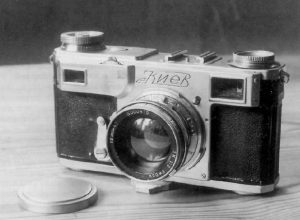
The first Kiev camera was called the Kiev II, due to it being an exact replica of the Contax II (there was never a Kiev I). In fact, calling the Kiev II a replica of the Contax isn’t entirely accurate as many of the very first models were built using spare parts built in Germany for the Contax. If you take apart an early Kiev II and look behind the name plate, you’ll see the original stamping that said Contax, which was later flattened, and re-stamped with the Kiev logo.
By the mid 1950s, the Soviet Union had a fair selection of 35mm and medium format cameras at their disposal, but one type they didn’t yet have was a medium format SLR. The most popular camera of this type was made by a Swedish company called Hasselblad who during the war built a series of large format aerial cameras for use by the Swedish military and it’s allies. In 1948, Hasselblad would release a civilian camera called the Hasselblad 1600 F using the knowledge they learned building military cameras.
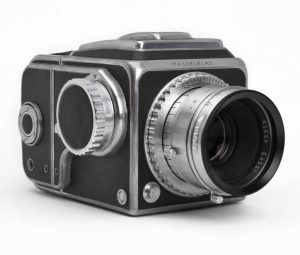
The 1600 F was a modular camera that had interchangeable lenses, viewfinders, and film magazines. A photographer could easily switch between wide angle and telephoto lenses or color and black and white film without ever having to reload the camera.
Although it saw some early success, the Hasselblad 1600 F proved to be a complicated and unreliable camera. In 1953, a new model called the Hasselblad 1000 F would make it’s debut with a redesigned shutter that was more reliable, and a slate of other improvements. Hasselblad’s cameras would start to gain worldwide recognition for their quality and superiority.
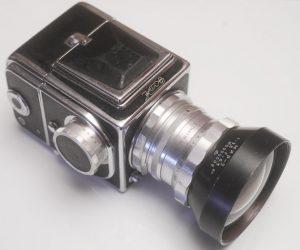
In 1957, a Soviet version of the Hasselblad 1600 F would be produced at the Arsenal factory in Kiev as it was the Soviet optics factory best suited to build such a complex camera. Unlike the Kiev rangefinders produced there who were built using the exact tools and machinery created by Zeiss, the new medium format SLR would have to be reverse engineered and built from the ground up.
When it was released, the Salyut (Салют) was very similar, but not identical to the Hasselblad 1600 F. For starters, it’s top speed was 1/1500, a speed which like the Hasselblad, proved to be unreliable and would be lowered to 1/1000 on later models.
The early cameras also came with a unique self timer that was also unreliable and would also be removed in later models. Despite these early problems, later versions of the Salyut proved to be as reliable as the Swedish cameras they were based on.
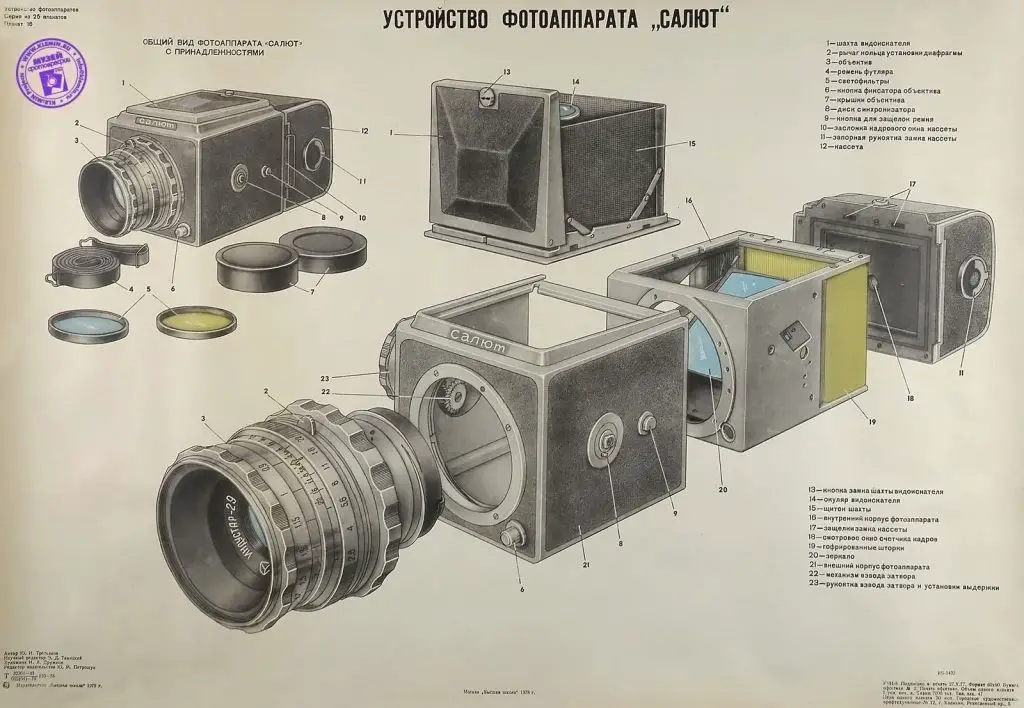
Like the Hasselblad it was based off, the Salyut was very expensive. Selling for 400 roubles, which at the time of it’s release was six months salary for the average Soviet worker, the camera could only be afforded by the most well to do photographers.
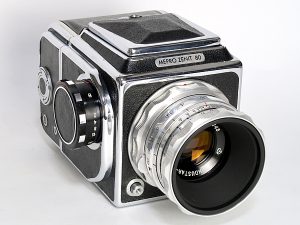
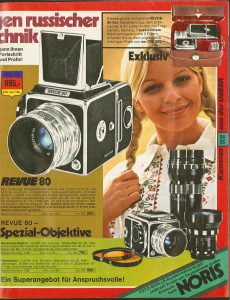
The Salyut was exported out of the Soviet Union, but most exported copies were re-branded as the Zenith 80, with a few making it to a Japanese distributor as the Mepro Zenit 80, and a few more sold as the Vitoflex and Revue 66 and Revue 80. Other than the name, exported cameras were identical to the ones sold in the Soviet Union.
The original Salyut was produced until 1972 and in that time, excluding the Zenit/Zenith exported models, three variations were created. The original, which has both a self-timer and a top 1/1500 shutter speed, and intermediate model with only the top 1/1500 shutter speed, and the third, and most common version with a top speed of 1/1000 and no self-timer.
In 1972, an updated model called the Salyut-C (sometimes called the Salyut-S due to confusion between the Cyrillic “C” and Western “S”) was released which was the same basic camera with only two changes. The first was a change to the lens mount adding a pin to support lenses with an automatic diaphragm, and the second a new lens supporting the feature, the 90mm f/2.8 Vega 12B.
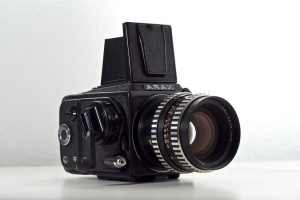
The Salyut-C was replaced in 1980 by the also similar Kiev-88 which added a flash hot shoe and some other cosmetic changes. The Kiev-88 would lead an interesting life as it was produced in great numbers with many never being sold, which in turn, after the collapse of the Soviet Union allowed new old stock inventory to be re-sold by a variety of third parties such as Arax, Brenner B.I.G, Cambron, Hartblei, KievUSA, and Wiese Fototechnik. Versions of the Kiev 88 with the original Salyut mount or with the Pentacon Six were available as were those with pentaprism viewfinders and a variety of other changes which were made to repair or improve the reliability of the original model.
With such a long production life from 1957 through the late 1980s, a huge number of Salyut-family cameras have become available, and considering the still sky-high cost of Hasselblads, these Soviet 6×6 SLRs are often seen as a cost effective alternative to the real thing.
In the July 30, 2005 issue of Amateur Photography magazine, Ivor Matanle wrote a wonderful five page article about the Arsenal Salyut and the family of cameras through the Kiev 88 suggesting that these cameras, when found in good condition, were still excellent cost effective options in 2005 when the article was written. Matanle starts off with some history, goes over the operation of each models, and most importantly, gives some tips on what to look for if you wanted to buy one yourself, all things that are still relevant today, in 2021.
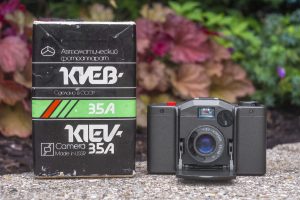
Along with the Kiev/Contax cameras, the Arsenal factory would build a variety of other cameras, most based off existing designs by other companies, but none using the original machinery like the Kiev rangefinder. These other cameras like the Minolta 16 inspired Vega from 1959, the Pentacon Praktisix inspired Kiev 6c from 1971, and the Minox 35EL inspired Kiev 35A from 1985 all looked very similar to the models which they were inspired off, but were all simplified and less expensive copies. Many of these Kiev copies had a poor reputation for build quality, but due to their cheap cost, are often sought out as inexpensive alternatives to the original designs.
Today, the Kiev 88 is a very desirable camera for collectors and users alike for many of the same reasons they were appealing when they were new. The Arsenal factory did a good job of replicating the experience of much more expensive medium format SLRs, but at a discount price. Soviet cameras from the 1980s aren’t known for having the best build quality, but like other Soviet cameras, the older ones are generally built better.
Although they’re not as easy to find as the later models, especially in the United States, Salyut cameras generally hold up well over time. They’re much cheaper to buy and even if you get one that doesn’t work, the price you’ll likely pay for the camera and then sending it out for a CLA, you’ll likely still save money from buying other Swedish, German, or Japanese alternatives.
My Thoughts
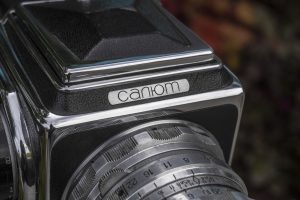
I have to imagine at least one or two people over the more than half century since the first Salyut was created saw the Cyrillic Салют name and mistook it for something made by Canon. As a quick glance, the name does sorta look like Canon, or at least Canom, which for the unsuspecting eBay seller or estate sale auctioneer, might think this is a Japanese camera.
Of course, it isn’t, in fact, it’s about as far from a Canon camera as you can get as Canon never made a 6×6 SLR like this, in fact, Canon has never made any medium format film cameras, ever!
I came about this Salyut in a roundabout way. I had been interested in 6×6 SLRs, having owned a Mamiya M645 and not really loving it’s eye level pentaprism. I knew that waist level was the way to go, but with a large selection of 6×6 TLRs and a Pentacon Six TL which I recently reviewed, I figured I needed to go big or go home so I set my sights on a Hasselblad.
I didn’t care which one, I figured it would most likely be a 500C or something similar, but I wasn’t picky, so I would consider a 1600 or 1000 if I could find one in my budget. Of course, finding any Hasselblad for sale in my budget is nearly impossible, so one day while visiting Gary Camera in Merrillville, Indiana, the shop owner had a 500C on the shelf. He said it didn’t work, but I wanted to try it out anyway. I’ve borrowed cameras from the owner, Barry before, so he agreed to loan it out to me and I figured I would tinker with it and see if I could get it working.
Fast forwarding a bit here, I did end up getting the Hasselblad to work, as it’s problem was the coupling between the body and the shutter in the lens. Despite getting past that problem, the camera had some other issues too, but it was too late for me, as the Hasselblad bug hit. Discouraged by the prices, I started looking for Kiev 88s. Like most Soviet cameras, the Kiev 88 can be found at a discount to the cameras they were based off, and after looking at a few, I couldn’t find the right combination of good looking and working, so as a last ditch effort, I expanded to the Salyuts and there it was.
KEH Photo in Georgia had this Salyut in what they considered Ugly condition. There was no statement of functionality, but looking at the pictures on their site, the camera looked to be in really nice shape. I took a chance, thinking that even if it was dead, I could still get an idea of what it might be like and I could probably flip it as a decorative piece close to what I paid for it.
When the Salyut arrived, I was amazed at it’s condition. As they often do, whoever does the grading at KEH must have been phoning it in that day as this camera was in great shape. It was a bit stiff, but everything worked, and as I continued to use it, it loosened up even more.
Although the Salyut is not an exact copy of the Hasselblad 500C, it is close enough to warrant some comparison. To do a true comparison, I would need either an 1600F or 1000F which I do not have access to.
Overall size is about the same in every dimension. The Zeiss Planar 80mm f/2.8 lens has somewhat of a taper to it’s front ring, giving the illusion of a more compact lens, but dimensionally is about the same size as the Soviet Industar-29 80mm f/2.8 lens. The Salyut is marginally heavier at 1462 grams with lens, hood, and film compartment compared to the 500C at 1429 grams, but this different is negligible as they’re both heavy metal cubes.
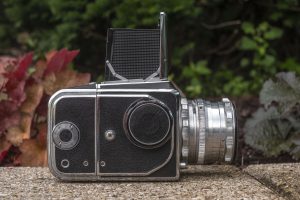
Operationally, the two have some differences as the Salyut uses an in body focal plane shutter with top 1/1000 speed, and the Hassy has a leaf shutter in it’s lens, and a top 1/500 speed. The Hasselblad has a fold out handle on the film advance knob compared to the Salyut which is just a knob, and also has an automatic diaphragm so that the viewfinder is always bright when composing, whereas the Salyut is semi-automatic and requires you to manually open the lens diaphragm using a spring loaded lever on the lens. Neither camera has an instant return mirror.
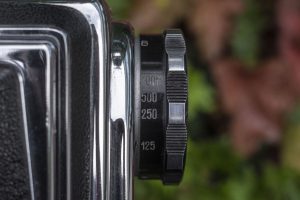
Looking at the camera’s left side we see the film advance knob, a strap lug, and on the side of the film magazine are film safe indicators, the exposure counter, and a manual film advance knob, which I’ll explain later.
Warning About Shutter Speeds: Like many other Soviet cameras, you cannot change shutter speeds without first winding the film advance knob. Doing so may damage the camera.
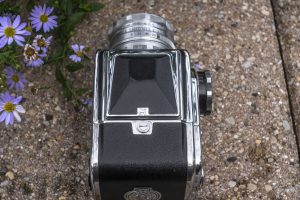
Beyond these differences, the user experience is pretty similar. Up top, the waist level filter hood pops up with a gentle slide of the small round latch near the back lip of the hood. The larger latch is for the film compartment which I’ll get to later.
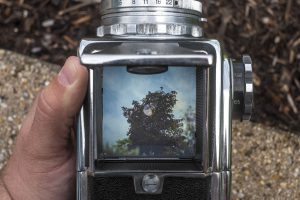
With the hood open, three spring loaded sides to the hood should pop up allowing you to see the focusing screen. Interestingly, on both the Salyut and the Hasselblad, these sides get hung up on the flip up magnifying glass suggesting this was a common problem with both cameras. It’s easy to overcome though as a gentle forward press on the magnifier allows them to continue moving.
The focusing screen has a subtle Fresnel pattern to improve brightness and also a bright split image focusing aide in the center. The normal Industar-29 lens has a semi-automatic diaphragm, which means you have to manually open it using a lever on the side of the lens. You can still shoot the camera without opening the diaphragm, but when stopping down the lens, the view through the viewfinder will be very dark. With the diaphragm wide open, the view through the ground glass is pretty bright. It’s certainly not as bright as more advanced Mamiya or Bronica SLRs, but for a 1957 Soviet camera, it was a lot better than I thought it would be. The split image focusing aide is very helpful, but definitely needs the lens to be opened all the way before it can be used. Forgetting to open the diaphragm with the lens stopped down will cause one half of the split images to always be dark.
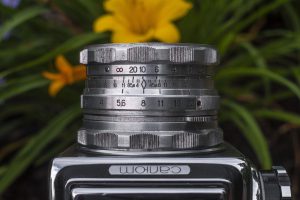
The Industar-29 lens works like most SLRs lenses, in that there’s a ring for focus and one for stopping down the lens. The aperture ring has strong click stops at each f/stop, making it easy to feel without having to look at the numbers. Using the previously mentioned lever in the paragraph above to stop down the lens, you are free to choose whatever f/stop you want the lens to stop down at the moment of exposure. Both the focus and aperture rings have deep knurls, making them easy to locate and turn with your eye to the viewfinder.
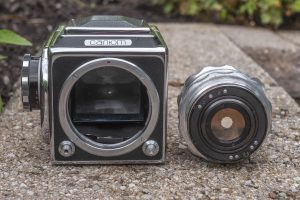
The lens mount is a bayonet design and is released using the button near the 4 o’clock position around the lens mount. A quick clockwise twist and the lens comes off.
From this image, you can also see the cable threaded shutter release button near the 8 o’clock position around the lens. Pressing the shutter release requires a moderate amount of pressure which if you’re not familiar with the camera, can cause body shake, however I found that with slow, and consistent pressure, there are three points of friction that must be overcome. The first is the semi-automatic diaphragm closing (assuming you set it), the second is the shutter beginning it’s release cycle, and the third is the actual shutter firing. I found that when shooting the Salyut, I could press the shutter release to release these first two clicks and hold it there until the exact moment I wanted to fire the shitter, and when I did that, it required very little effort, almost completely eliminating body shake.
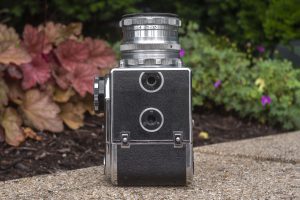
Flip the camera over and the bottom has two 3/8″ tripod sockets. This being a Soviet camera, if you’d like to stabilize the camera to a modern tripod, you’ll need a 3/8″ to 1/4″ adapter. Aside from that, the only things here to see are two small feet which help balance the camera when placed on a flat surface.
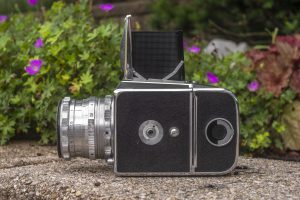
The camera’s left side has the flash sync port with a ring around it for selecting M or X sync, depending on what kind of flash you intend to use. Behind it is one of the lugs for a neck strap, and the opening for the (not shown) dark slide.
As with most magazine back cameras, the Salyut uses a metal dark slide which covers the film gate in the magazine, protecting the film inside from light so that you may swap magazines mid roll without ruining your film. With the dark slide in, it engages a shutter lock, which prevents you from being able to fire the shutter with the slide in. If you are playing around with a Salyut and you’re sure you’ve cocked the shutter, but still can’t fire the shutter, check that the dark slide is removed. Finally, on the side of the magazine is the release lock for the removeable film holder.
Loading Film
Loading film into the Salyut is done without having to remove the magazine from the back of the camera. The entire process is similar to most other medium format SLRs by Hasselblad, Mamiya, Bronica and others but there are some differences that the first time user should be aware of.
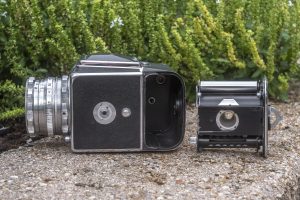
Step 1
On the camera’s left side, fold out the release handle on the magazine and give it short counterclockwise turn and pull the entire film holder out.
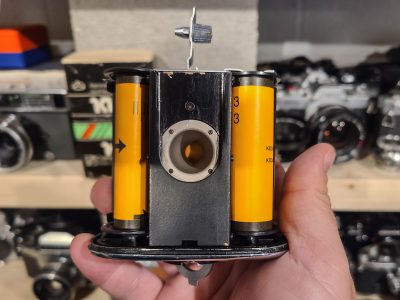
With the film holder out, you have easy access to both the supply and take up side. Hinged metal arms fold out of the way making attaching a 120 film spool very easy. It is easy to identify the take up side as it has a tapered metal gear sticking out of one side.
Step 2
To load film, first move an empty spool to the take up side, and then load in a new roll of film into the other side. The take up side is the one with the knurled metal post on one side. The direction of the film is critical when loading as the black backing paper must face AWAY from the film holder. Wrap the paper leader around the metal roller, across the film plane, then around the other metal roller and onto the take up spool just like you would any medium format camera.
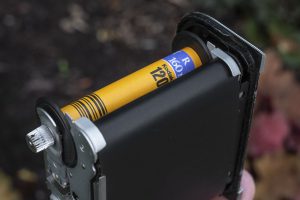
There are two curved metal guides on the edges of the side near the metal roller on the take up side that you must thread the backing paper beneath. The image to the right shows how it should look. Also notice the black backing paper is facing out. If you can see any printing on the backing paper facing out, you have the film loaded backwards!
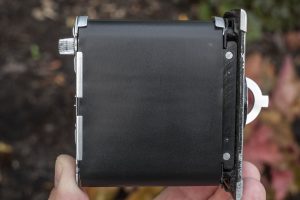
It helps when loading the magazine back into the camera to make sure the backing paper is tucked under the two rectangular metal tabs on the left of the image to the left. You can easily do this by turning the magazine’s locking ring to release tension on the tabs and sliding the paper under. If you do not do this step, there is a chance the paper will be caught up on the camera as you insert it into the camera.
Step 3
Before inserting the film holder back into the magazine, you must remember to rotate the main film advance knob on the body of the camera to cock the shutter. Sometimes the shutter will already be set from advancing the film after the 12th exposure of the previous roll. However you choose to do it is fine, as long as the shutter is cocked before inserting the new roll of film into the camera. You can confirm the shutter is cocked if the reflex mirror is down allowing you to see through the viewfinder. Failure to cock the shutter before inserting a new roll of film will result in the loss of the first exposure!
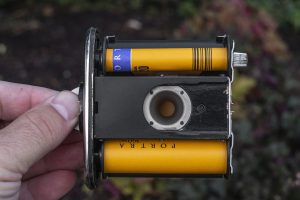
With the film wrapped around the film plane, under the guides, attached securely to the take up spool, and the shutter cocked, you can finally insert the film magazine back into the camera. Unlike other medium format SLRs which have some kind of index dot that must be lined up with a starting line on the film’s backing paper, with the Salyut, you just insert it into the camera whenever you can. You’ll use the numbers printed on the backing paper to line up the first shot, so there’s no need to line up any dots. Notice how in the image to the right, the yellow backing paper should be visible through the round hole. If you see black in this hole, stop immediately and reload the film.
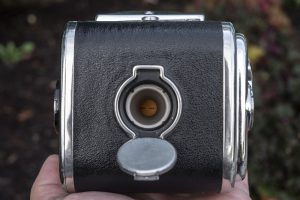
Step 4
Once the film holder is back in the camera and securely latched, take the camera somewhere with minimal lighting and flip open the round door so you can see the backing paper and advance the film using the manual film advance knob on the magazine (not the main film advance on the body) until the number “1” shows up and close the door.
There is no red window protecting the film, so it is very important that you do not let sunlight or other bright lights to shine through this window as it could expose the film through the paper.
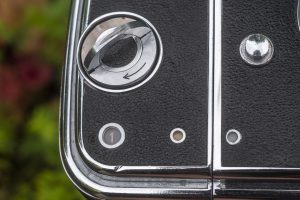
Step 5
The final step is to rotate the manual film advance knob on the right side of the magazine counterclockwise (opposite the direction of the arrow) to reset the exposure counter to the “1” position. Failure to do this will cause the exposure counter not to work correctly.
In the image to the right, notice there are two small round windows, one in the bottom right corner of the magazine and the other in the bottom left corner of the body. These are both readiness indicators, the one on the magazine to show if the film has been advanced, and the one on the body to show if the shutter is cocked. A red signal in either window means one is not ready. When shooting, both windows should be white.
With the camera loaded, you will rely on the exposure counter to know how many exposures have been made. Do not open the peep hole on the back of the magazine to see the exposure numbers on the backing paper throughout the rest of the roll.
After the last exposure, you must use the manual film advance knob on the magazine to wrap up the backing paper in preparation for removing the film from the magazine. As one last step, you may want to insert the dark slide into the camera to prevent the shutter from accidentally being released.
My Results
With what appeared to be a perfectly working camera, I took the Salyut out in late summer 2021 and shot back to back rolls of the film in it. The first was a slightly expired roll of Kodak Ektar 100, and the other a fresh roll of CatLABS X Film 80, which is a Chinese film made by the Shanghai film company for CatLABS. Although the CatLABS film is rated as ASA 80, I rated both it and the Ektar the same.
I’ve been on a bit of a medium format SLR kick as of late. In this year alone, I’ve shot and written reviews for the Bronica S2, Pentacon Six TL, Hasselblad 500C (coming soon), and now the Arsenal Salyut. I learned pretty quickly, that for as good as the Pentacon Six is, and I know it has it’s fans, I just do not like the ergonomics of it. I do not think the shape of the camera which dates back to the Kochmann Reflex-Korelle holds up too well. Adding to the fact that with the pentaprism viewfinder which my example had, made it feel like I was holding a square bowling ball to my face each time I looked through the viewfinder.
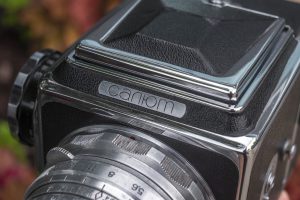
I much prefer the waist level layout of the Bronica, Hasselblad, and Salyut, except each of the first two examples had issues. The Bronica consistently missed focus, likely due to rotted foam that I couldn’t completely resolve, and the Hasselblad was in badly need of a CLA due to a laundry list of technical issues.
For the Salyut, I had high hopes it would become my go to medium format SLR. It certainly looked nice and appeared to be in great shape when I got it. The process of using the camera was pleasant. Like the Hasselblad, advancing the film only required one single rotation of the film advance knob, unlike the Bronica which takes several. Also unlike the Bronica, I didn’t feel like the camera was about to break every time I advanced the film. Effort and noise was a little louder than the Hasselblad, but not excessive like the Bronica.

Even the viewfinder was really good. I’m sure that with some kind of aftermarket focusing screen like one of Rick Oleson’s Bright Screens, it could have been better, but for a Soviet made SLR that dates to the late 1950s, it was much better than I expected, and I also loved the inclusion of the split image focus aide.
The images in the gallery above are all very sharp corner to corner and compare favorably to those shot on those other cameras. The 4-element Industar-29 isn’t as impressive on paper as the 7-element Zeiss Planar on the Hasselblad or the 5-element Nikkor-P on the Bronica, but to my very unscientific eye, I was very happy with the results. Contrast in the CatLABS 80 film was high but still pleasant, and the lens was able to take advantage of the fine grain to great effect. In the images shot on Ektar 100, the color rendering was superb. Kodak Ektar film is pretty picky with exposure and will often render strange color casts if the right exposure is not made, so I was pleased to see most of the images came out with accurate and vivid colors.
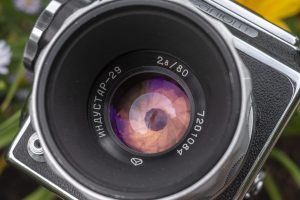
Sadly, not everything was perfect as the camera had two issues. The first, which should be easy to resolve, were some vertical light leaks in some images like the black and white image of the railroad crossing. That day I was in direct sunlight for an extended period of time, so I imagine that some light leaked in from the sides, perhaps by the dark slide, as the other low-light images don’t show it.
The second issue is more of a concern as it appears the shutter curtains are out of adjustment as a most images look darker on one side than the other. Most of the color images show this as do the black and white images of the beer truck and Pilot gas station. This could be an issue at only the faster speeds, which I’ll have to do more testing to confirm. Sadly, this isn’t something I can fix myself, but might be worth getting looked at if I can find someone in the US willing to repair a Salyut.
These two issues aside, I can say that I loved using the Salyut. I’ve always thought of myself as a fan of Soviet cameras, but I also am realistic about what they are capable of. I’ve said many times that Zorki and FED rangefinders aren’t as good as the original Leica II, but that they don’t have to be. For a camera that costs a fraction of the price as the real thing, but delivers almost 90% of the same quality and user experience, they’re worth owning.
In the case of the Salyut, maybe I just got REALLY lucky with this mostly usable copy, but if others are anywhere close to this, then I absolutely think these are cameras worth owning. The ergonomics are great, the viewfinder is very usable, especially for people like me with poor vision, and the image quality of the modest Industar-29 is a lot better than you might expect. Considering the prices these can usually be found at, this one’s a no brainer and an easy camera for me to recommend!
Related Posts You Might Enjoy
External Links
http://camera-wiki.org/wiki/Salyut
http://sovietcams.com/index925e.html
https://fotoussr.ru/cameras/salut/ (in Russian)
http://ussrphoto.com/Wiki/default.asp?WikiCatID=79&ParentID=1&ContentID=67&Item=Salyut
https://www.photo.net/discuss/threads/kiev-salut-medium-format-anyone-have-any-opinions.211584/

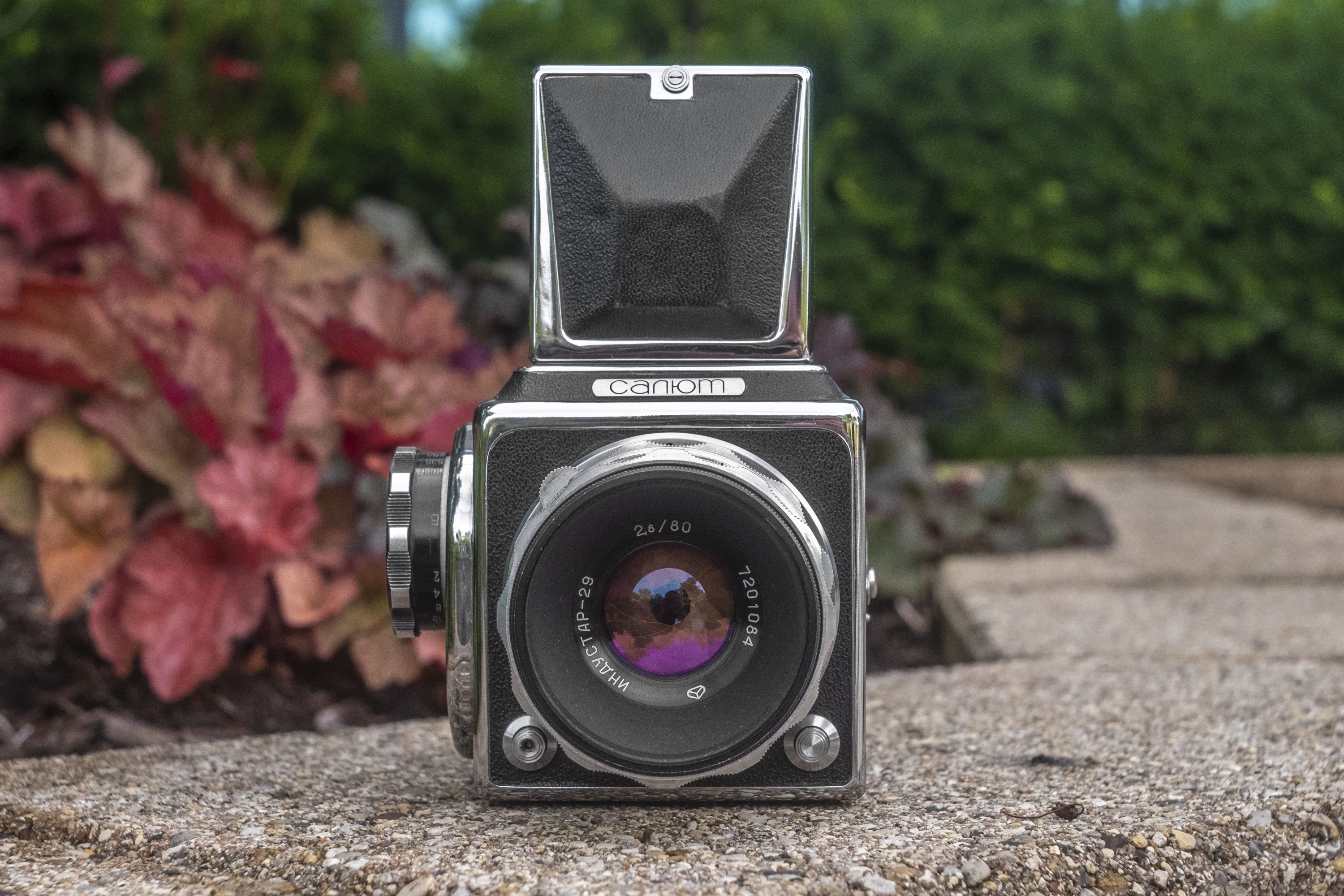
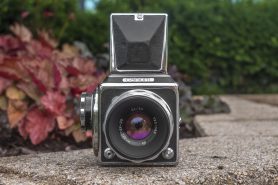
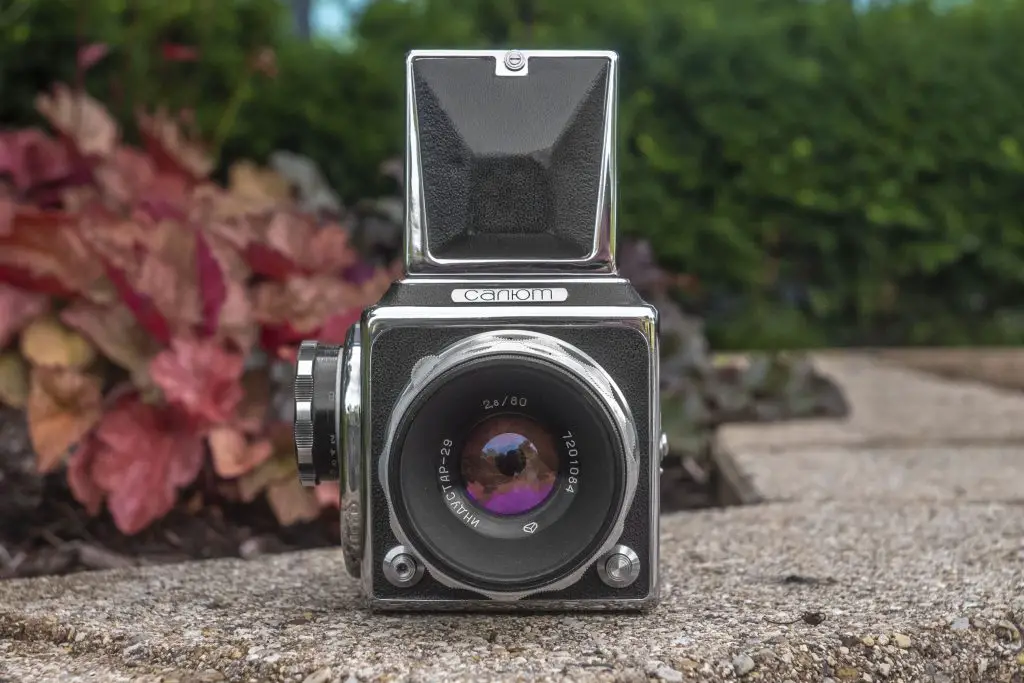
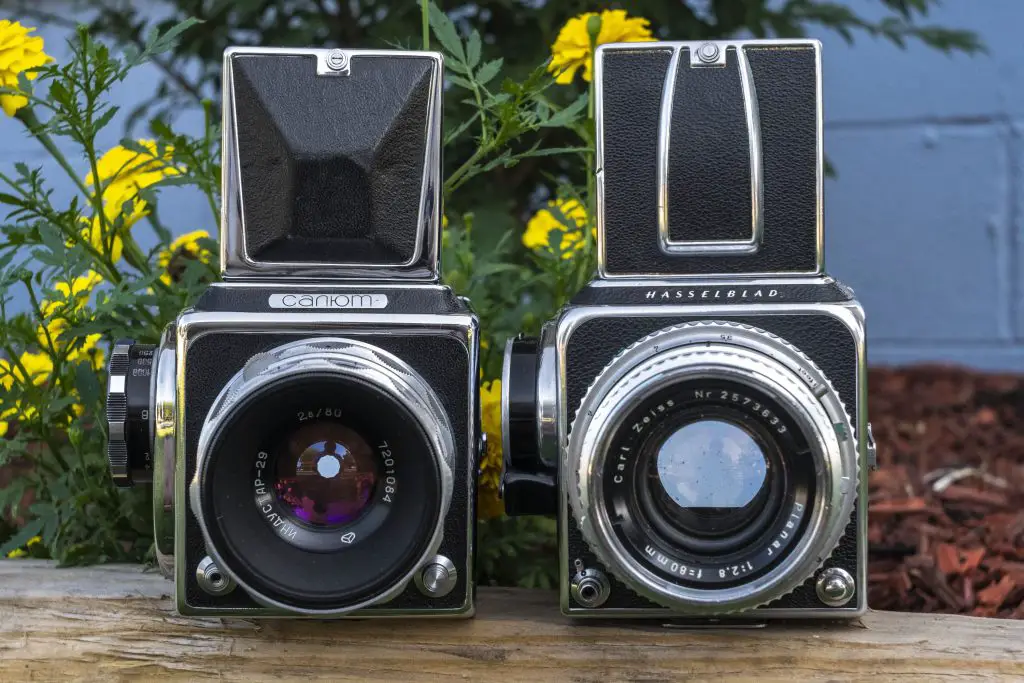
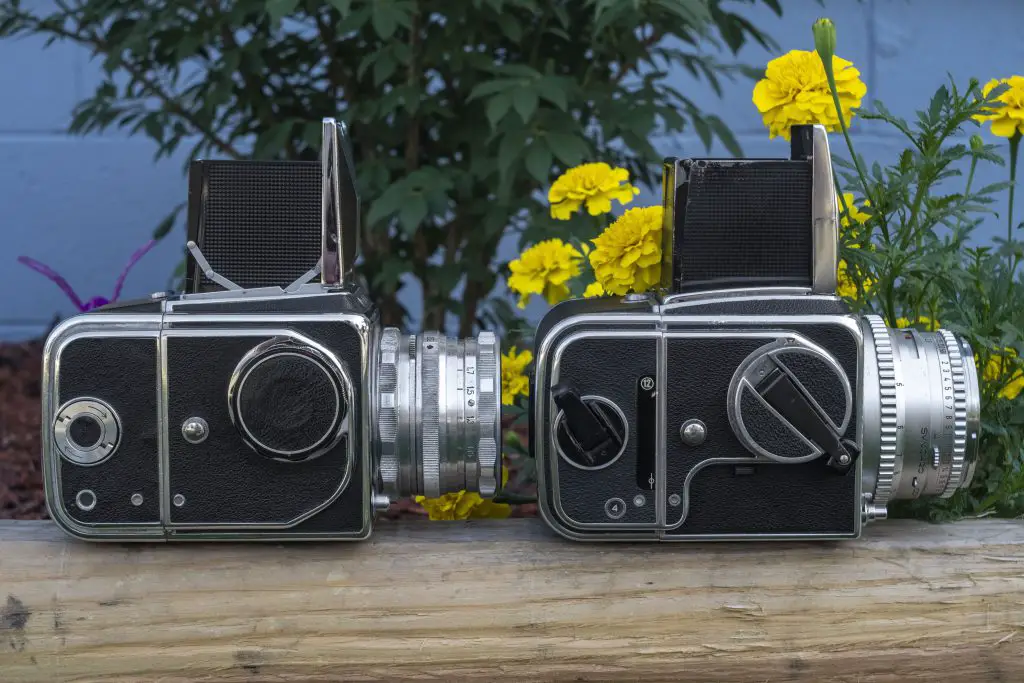
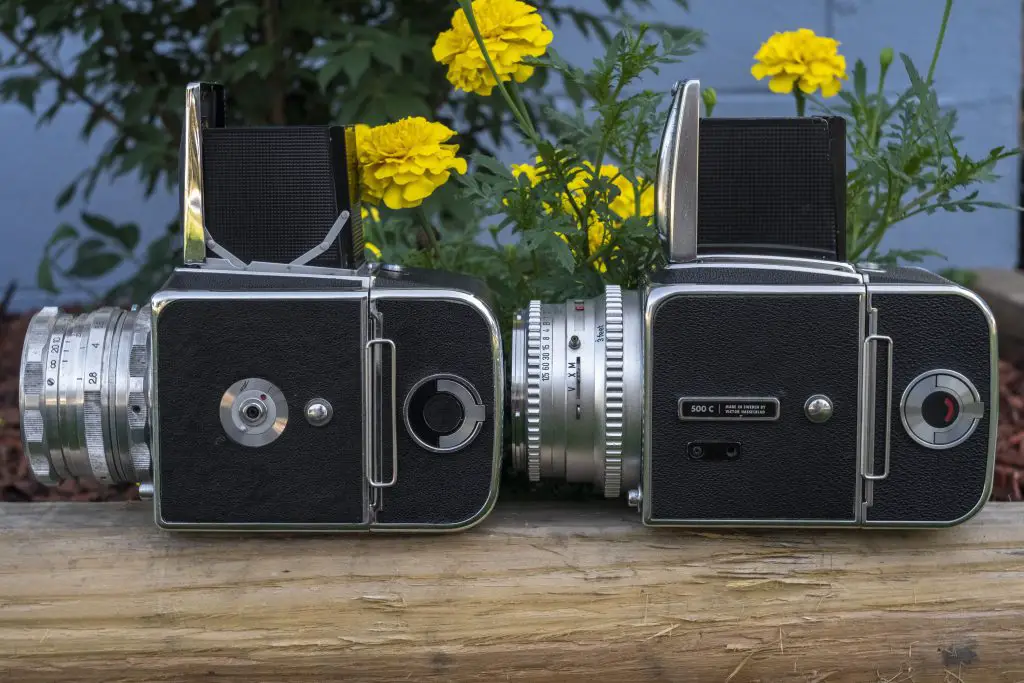
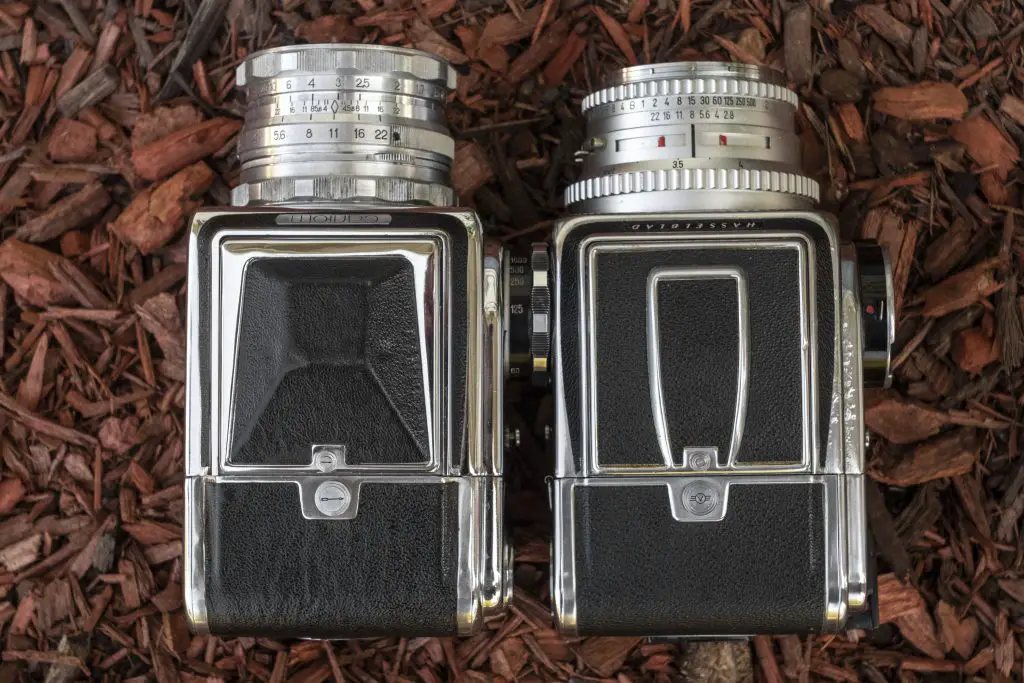




















Mine was a nightmare. Everything seemed to break..Lenses were very good- especially the wide angles
I love this camera!!! My first medium format SLR was a Kiev60, but I always lusted after a Hassy. Back in the 90s, I found a Zenith 80 for under $100 and was hooked, eventually getting a later model Salyut and then a Kiev 80 … they all are fun to use!!!
Yeah, I really like mine. I thought I would love the Bronica S2, but I like this one more. I just need to sort out the shutter timing issues!
Hi Mike, the Salyut looks amazing. I’d really like to get into MF, but right now have other needs and priorities.
Can I give a suggestion? Could you please add the option to search reviews by date? I’m sure I’ve missed a couple, but they’re now impossible to find in your massive database.
Thanks for the feedback! You’re right, the Salyut is an impressive camera that’s even nicer in person than the photos show.
As for your suggestion, you can already search by date. If you use the search box and type in 1957 for example, the first search results will be cameras with 1957 in the title. If you were thinking however, of some kind of index, that would be a little more work. Building the index is easy enough, but I’d need to go through each and every review I’ve ever written, and tag each post with a year so the index can find it. Perhaps a compromise might be an index by decade. Let me know what you think.
That’s a nice feature, but I was thinking rather of the chronological order in which the reviews have been published – can I search the months of publication, for example? That’d be more than enough. Thanks!
WordPress allows you to see posts published in a year or month by manually modifying the URL. If you look at the link for everything on the site, the year and month is there. So if you wanted to see reviews posted in October 2021, you’d go to: https://mikeeckman.com/2021/10/
I don’t currently have an index though that automatically generates these links however, but I can look into seeing how easy it is. I’m all for making the site more accessible because I know I have a ton of content, but it’s also a lot of work to manually edit each post as I have well over 300 of them! 🙂
Excellent, that’s the kind of thing I wanted. Good to know that you’re working on the site as well, I love your reviews
Oh, and an index by decade sounds great, too. Maybe divide the ‘60s and ‘70s in two, because those seem to concentrate the most reviews. It’d be informative to see contemporary cameras along each other, to see bigger trends in the industry.
I actually really like this idea and will look into getting it setup, when time allows. 🙂